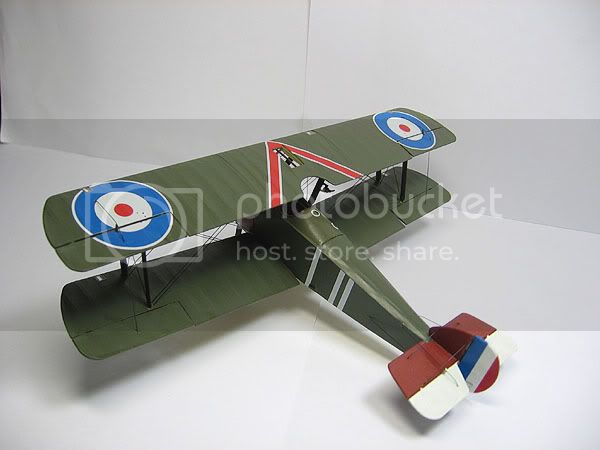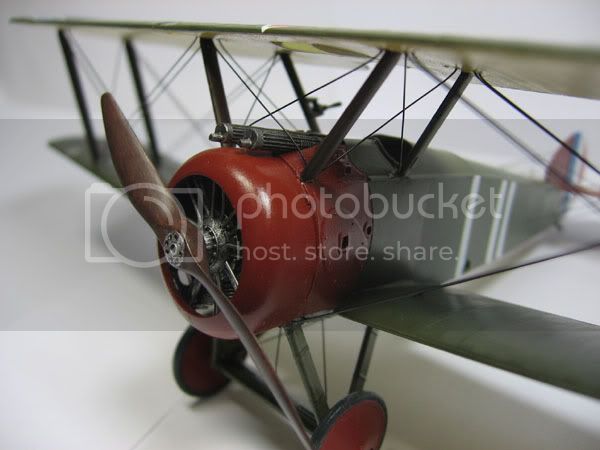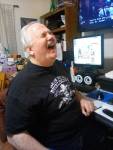Thanks for the compliments.

The parts didn't have any holes, I had to drill them. Fortunately almost all holes were marked with small rivet-liket dots. Some reference pictures come in handy, because the rigging diagram in the instructions is a little vague.
I'll now try to describe the building process as accurately as I can remember.
I startered the build as the instrcuctions suggested, with the engine, it's mounting, and the cockpit. The engine came together nicely, but the pushrods are molded together with the two front parts of the engine. They were pretty fragile, and I broke off most rods from the front part. Fortunately it was easy to replace the broken rods with copper wire.
Next I tackled the instrument panel and mg mount. Dial faces came as decals. They snuggled down nicely with micro sol.
The cockpit interior was easily built. Just be careful with the wicker decals that go to the seat, especially with the one that goes to the inner curve. Prepainted seatbelts came on the PE fret, I coated them with matt clear to protect them while handling.
Then it was time to close up the fuselage. I had to widen the rear-most cockpit mounts with styrene strip. I didn't add the tailskid at this point, as it looked fragile.
Next came the lower wing, to which I glued the seperate flaps, cockpit floor and control stick. Then I attached the lower wing to the fuselage. To get the wing to sit properly, I had to cut the firewall mounts which were in the way. I just used clippers (the result doesn't have to be pretty), it's impossible to see in the finished model anyway. At this point the instructions tell you to attach the rear parts of the machine guns before glueing on the upper fuselage. Don't do this! It's much easier to glue on the completed mg's, and you get the two parts aligned properly, too. I then assembled the mg's and painted them. Take care to sand the mating surfaces flat so the mg's will be straight.
The vertical and horizontal stabilizers were also attached at this point. Again, I glued the control surfaces in place before attaching to the fuselage.
The instructions then tell you to attach the upper wing, which I didn't do yet. I assembled and glued on the landing gear, but left off the wheels for now. Here I made a mistake. I thought that the steps at the end of the landing gear legs are because of mold misaligment and sanded them away. Don't do that, they're actually connectors which fit to small holes in the fuselage bottom. I had to glue small bits of styryne to help fixing them.
Next came the top wing. I glued the fuselage struts to the upper, and outer struts to the lower wing. I fixed the wing in place with masking tape to get the struts aligned properly. (I recommend making attachment pins from metal wire for the outer struts, as the bonding area is small and weak and I eventually broke off three of the struts while working)
Then It was time to start painting. The upper wing was painted and decaled separately. For the paint scheme, I chose the classic green overall with red engine cowling and fron fuselage. The markings were for Capt. Roy Brown's plane. (The instruction tell it was Sopwith Camel F.1 B7270, Capt. Roy Brown, NO 209 sqn, Berfangles, France, April 1918) The model was first primed with vallejo's grey primer. Model color paints from the same manufacturer were used for the other colors as well. The red cowling, wheel hubs, and horizontal stabiliser were painted with cavalry brown (no. 982). The green is dark green (no. 893). The instructions told to paint the fuselage around the cockpit and the langing gear with a 5:1 mix of dark green and wood brown, which I did. For the brown I used beige brown (no. 875). I don't think it's absolutely necessary, as the difference is hardly noticable. For the linen parts, I used yellow ochre (no. 913). Masks are included in the kit, but I only used them for the wheels.
I coated the model with johnson's floor wax prior to applying the decals. Speaking of the decals, they were great, as usuall with eduard. They snuggled right into the details with a little micro sol. Then I applied a couple of coats of a mix of floor wax and tamiya flat agent, which produced a nice sating sheen. I left the cowling glossy, though. Next came attaching the upper wing. I used two-part epoxy for this. I had to mix up a couple of batches of it before I got the wing and all the struts aligned and attached. Again, masking tape held the wing in place while the epoxy cured. Then it was time for rigging. I carefully re-opened any holes that had paint in them. I used black fishing line for all the wires, attached with superglue. After the glue dried, I trimmed the extra off and shaved off any extra glue on the upper and lower wing surfaces. After a little touch-up, I was almost done. I wasn't sure how to touch up the holes on the roundels. I tried to touch-up with white, but that looked awfull, so I wiped it off. But I was able to touch-up the blue areas with citadel's enchanted blue, as it matched the blue on the decals almost perfectly.
The propeller was first painted with citadel's scorched brown, then drybrushed with a lighter brown and then came a black wash (I used lifecolor's "oil" wash). The woodgrains were then done by drybrushing with a really coarse plastic brush (actually, the first brush I ever got. It came with a revell kit with two tins of paint. Those were the days...).
Then I attached the tailskid, wheels, machine guns, and the propeller, and the model was finished.
I hope this was helpful and didn't bore you to death.




























































 these beers are KEO's
these beers are KEO's











